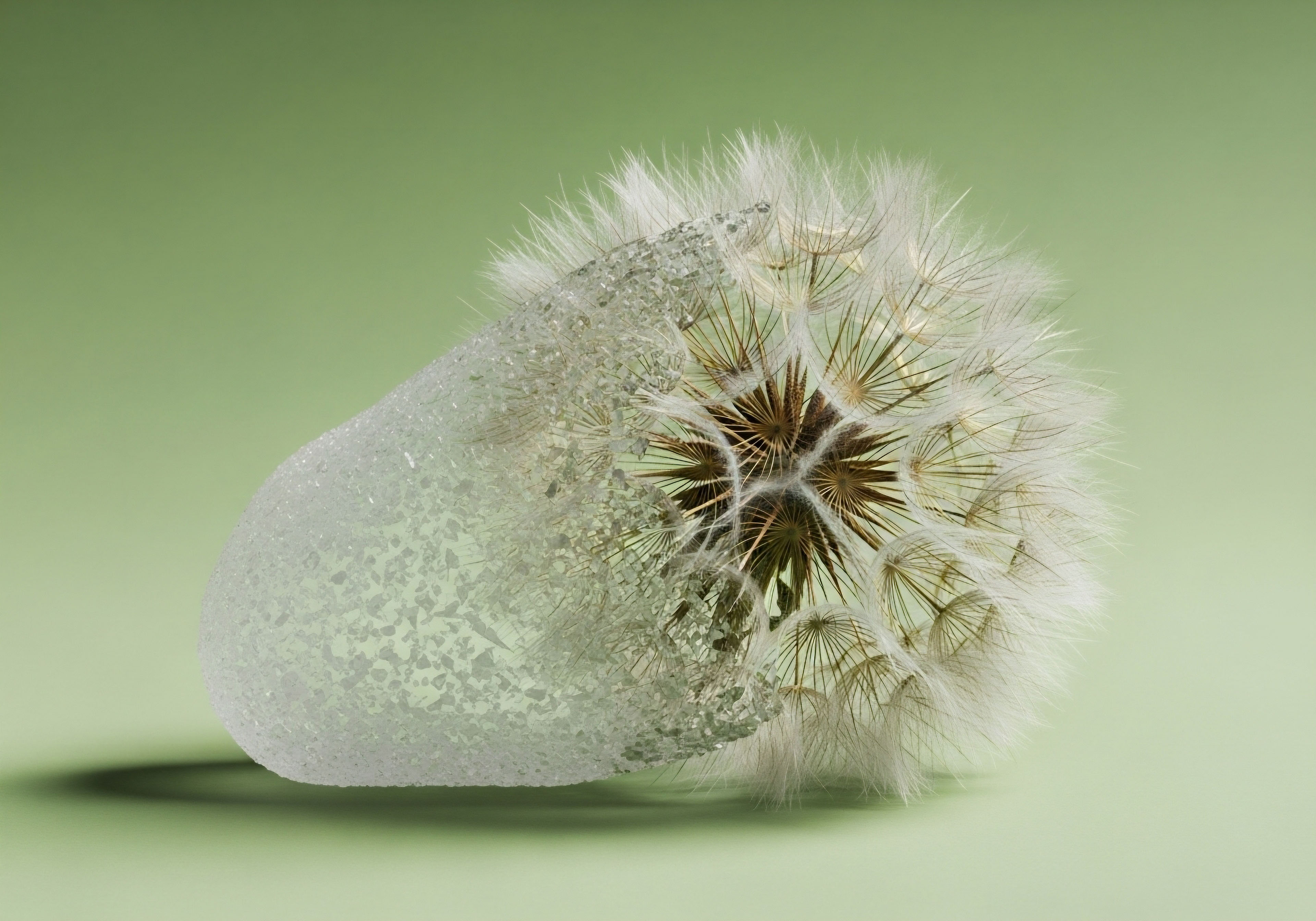

Fundamentals
You may have noticed a subtle shift over time. The energy that once propelled you through demanding days now seems to wane sooner. Recovery from physical exertion takes longer, and maintaining the physique you once took for granted requires a level of effort that feels unsustainable.
These experiences are not isolated incidents of fatigue or a lack of discipline. They are often the surface-level manifestations of deeper, systemic changes within your body’s intricate communication network, the endocrine system. Your internal symphony of hormones, which once played in perfect concert, may now have instruments falling out of tune. This is a common part of the human experience, a biological reality that many adults face as they navigate their personal health timeline.
Understanding this internal environment is the first step toward reclaiming your vitality. The conversation about hormonal health often revolves around individual hormones in isolation, such as testosterone. While restoring testosterone to optimal levels through Testosterone Replacement Therapy (TRT) is a significant step in addressing symptoms like low energy, reduced muscle mass, and a subdued libido, it represents only one part of a more complex biological picture.
Your body’s hormonal axes are deeply interconnected. The systems that regulate testosterone also communicate with those that govern growth, metabolism, and cellular repair. This is where the concept of a more comprehensive approach to hormonal wellness becomes so relevant.
Addressing hormonal decline requires looking at the entire endocrine system as an interconnected network, not just a collection of individual hormone levels.

The Endocrine System a Symphony of Signals
Think of your endocrine system as a global communication network. Hormones are the messengers, carrying vital instructions from command centers like the pituitary gland to every cell, tissue, and organ in your body. Testosterone is a primary messenger, responsible for a wide array of functions that contribute to what we perceive as vigor and strength. When its signal weakens, the effects are felt system-wide. TRT works by replenishing this specific messenger, amplifying its signal and restoring its crucial functions.
However, another key set of messengers, those related to human growth hormone (HGH), also play a fundamental role in this network. HGH is the master hormone of cellular regeneration, repair, and metabolism. Its production is also governed by the pituitary gland and naturally declines with age.
This decline contributes to changes in body composition, such as an increase in visceral fat, a decrease in lean muscle mass, and a reduction in skin elasticity. It also affects the quality of your sleep, which is the body’s prime time for repair and rejuvenation.

Introducing Growth Hormone Peptides
Directly supplementing with HGH can be a blunt instrument, sometimes leading to an imbalance in the delicate endocrine feedback loops. A more refined approach involves using growth hormone peptides. These are short chains of amino acids that act as precise signaling molecules. They do not replace your body’s own growth hormone.
Instead, they stimulate the pituitary gland to produce and release HGH in a manner that mimics the body’s natural rhythms. This method offers a more subtle and regulated way to restore the growth hormone signal, working in concert with your body’s innate biological intelligence.
Peptides like Sermorelin, Ipamorelin, and CJC-1295 are known as growth hormone secretagogues (GHSs). Each has a unique mechanism of action, but they all share the common goal of encouraging your pituitary to function more youthfully. By doing so, they help to restore the regenerative processes that are essential for long-term health and well-being.
This is where the true potential of a combined therapeutic approach begins to emerge. When you combine TRT with growth hormone peptides, you are not just topping up two separate hormones. You are restoring two critical, interconnected signaling pathways, creating a synergistic effect that can lead to a more profound and comprehensive restoration of function.


Intermediate
For individuals already familiar with the foundational principles of hormonal health, the next logical step is to understand the clinical application and the specific mechanisms through which combined therapies exert their effects. Moving beyond the ‘what’ to the ‘how’ and ‘why’ reveals a sophisticated biological strategy aimed at systemic recalibration.
The decision to integrate growth hormone peptides into a TRT protocol is based on a deep understanding of endocrine synergy. It is a clinical choice designed to produce results that are greater than the sum of their parts, addressing the multifaceted nature of age-related decline in a coordinated fashion.
A well-designed hormonal optimization protocol is a highly personalized endeavor. It begins with comprehensive lab work to establish a baseline and identify specific deficiencies. Standard TRT protocols, often involving weekly intramuscular injections of Testosterone Cypionate, are highly effective at restoring androgen levels.
However, a forward-thinking clinician will also consider the status of the entire Hypothalamic-Pituitary-Gonadal (HPG) axis and the broader neuroendocrine system. This is where adjunctive therapies like Gonadorelin or Enclomiphene come into play, helping to maintain the body’s own hormonal signaling pathways while on therapy. The addition of growth hormone peptides represents another layer of this systemic approach.
Combining TRT with growth hormone peptides is a clinical strategy that leverages endocrine synergy to achieve a more complete and balanced state of metabolic and hormonal health.

Clinical Protocols for Combined Therapy
When combining TRT with growth hormone peptides, the goal is to create a physiological environment that supports both anabolic (tissue-building) and metabolic processes. The specific peptides chosen, along with their dosage and timing, are critical variables that are tailored to the individual’s goals and biochemistry.
- TRT Foundation ∞ The base of the protocol is typically a stable dose of testosterone, administered via injections or pellets. This provides a consistent androgenic signal, which is foundational for muscle protein synthesis, red blood cell production, and neurological function. An aromatase inhibitor like Anastrozole may be used judiciously to manage the conversion of testosterone to estrogen, preventing potential side effects like water retention or gynecomastia.
- Growth Hormone Peptide Selection ∞ The choice of peptide depends on the desired outcome. Some of the most commonly used peptides in combination with TRT include:
- Sermorelin ∞ A growth hormone-releasing hormone (GHRH) analogue, Sermorelin stimulates the pituitary to produce HGH. It has a relatively short half-life and is often administered daily before bedtime to mimic the body’s natural pulsatile release of growth hormone during sleep.
- Ipamorelin / CJC-1295 ∞ This is a very popular combination. CJC-1295 is a GHRH analogue with a longer half-life, providing a steady elevation in growth hormone levels. Ipamorelin is a ghrelin mimetic and a GHS that stimulates a strong, clean pulse of HGH without significantly affecting other hormones like cortisol or prolactin. When used together, they create a powerful synergistic effect, leading to a sustained increase in HGH and IGF-1 levels.
- Tesamorelin ∞ Another GHRH analogue, Tesamorelin has been specifically studied and approved for the reduction of visceral adipose tissue (deep abdominal fat). It is a potent stimulator of HGH and can have a profound impact on body composition.
- Administration and Timing ∞ Growth hormone peptides are typically administered via subcutaneous injection, often in the evening. This timing is strategic, as it aligns with the body’s natural circadian rhythm of HGH release, which peaks during deep sleep. This can enhance sleep quality, which in turn supports recovery and regeneration.

Synergistic Mechanisms of Action
The benefits of combining these therapies stem from their complementary effects on various biological systems. Testosterone and HGH work on different, yet overlapping, pathways to promote a state of optimal function.
The table below outlines some of the key synergistic effects of combining TRT with growth hormone peptides:
| Biological System | Effect of TRT | Effect of Growth Hormone Peptides | Combined Synergistic Outcome |
|---|---|---|---|
| Musculoskeletal System | Increases muscle protein synthesis and myonuclear density. Improves bone mineral density. | Stimulates collagen synthesis, tendon and ligament repair. Promotes hyperplasia (new muscle cell formation). | Enhanced muscle mass and strength, improved recovery from injury, and greater joint integrity. |
| Metabolic System | Improves insulin sensitivity and glucose uptake in muscle tissue. | Increases lipolysis (fat breakdown), particularly of visceral fat. Improves lipid profiles. | Significant improvements in body composition, with a simultaneous increase in lean mass and a decrease in fat mass. |
| Central Nervous System | Enhances dopamine release and androgen receptor signaling in the brain, improving mood and motivation. | Improves sleep quality and duration, particularly deep wave sleep. Supports cognitive function and memory. | Improved mood, mental clarity, focus, and a greater sense of well-being, supported by restorative sleep. |
| Integumentary System (Skin) | Increases skin thickness and sebum production. | Stimulates collagen and elastin production, improving skin elasticity and hydration. | Healthier, more youthful-appearing skin with improved texture and reduced fine lines. |

What Are the Safety Considerations for Combined Therapy?
When administered under the guidance of an experienced clinician, combined TRT and peptide therapy has a favorable safety profile. The use of peptides that stimulate the body’s own HGH production is generally considered a safer long-term strategy than direct HGH administration. However, monitoring is essential. Regular blood work is necessary to ensure that hormone levels remain within optimal ranges and to monitor for any potential side effects. Key markers to track include:
- Total and Free Testosterone
- Estradiol (E2)
- Insulin-like Growth Factor 1 (IGF-1)
- Complete Blood Count (CBC)
- Comprehensive Metabolic Panel (CMP)
- Lipid Panel
- Prostate-Specific Antigen (PSA)
By carefully managing dosages and monitoring these key biomarkers, it is possible to harness the powerful synergistic benefits of this combined therapeutic approach while minimizing risks. This level of personalized care is the hallmark of modern, proactive medicine.


Academic
An academic exploration of the combined application of Testosterone Replacement Therapy (TRT) and growth hormone secretagogues (GHSs) requires a shift in perspective from systemic benefits to the underlying cellular and molecular mechanisms. The profound phenotypic changes observed in patients ∞ such as improved body composition, enhanced physical performance, and a greater sense of well-being ∞ are the macroscopic outcomes of a cascade of microscopic events.
The true synergy of this dual-hormone approach can be understood by examining the interplay between androgen receptor (AR) signaling and the GH/IGF-1 axis at the cellular level, particularly within the context of skeletal muscle and adipose tissue.
Testosterone’s primary anabolic effects on muscle are mediated through the activation of the AR. This ligand-activated transcription factor, upon binding testosterone or its more potent metabolite dihydrotestosterone (DHT), translocates to the nucleus and binds to androgen response elements (AREs) on target genes.
This process upregulates the transcription of genes involved in protein synthesis, such as those in the mTORC1 pathway, and also increases the satellite cell pool, which is critical for muscle repair and hypertrophy. Concurrently, GHSs, by stimulating pulsatile GH release, activate the GH/IGF-1 axis. GH exerts its effects both directly, by binding to the GH receptor (GHR) on target cells, and indirectly, by stimulating the hepatic and local production of Insulin-like Growth Factor 1 (IGF-1).
The synergistic action of TRT and GHSs is rooted in the convergent and complementary signaling pathways of the androgen receptor and the GH/IGF-1 axis, which together create a powerful pro-anabolic and lipolytic cellular environment.

Molecular Crosstalk in Myogenesis and Lipolysis
The combination of TRT and GHSs creates a uniquely favorable environment for myogenesis (the formation of muscular tissue). While testosterone directly stimulates protein synthesis via AR activation, IGF-1, the primary mediator of GH’s anabolic effects, activates the PI3K/Akt/mTOR pathway. This pathway is a central regulator of cell growth and proliferation.
The simultaneous activation of both the AR and the IGF-1 receptor (IGF-1R) on myocytes leads to a more robust and sustained activation of mTORC1 than either stimulus alone. This results in an amplified rate of muscle protein synthesis and a greater increase in lean body mass.
Furthermore, there is evidence of crosstalk between these two pathways. Androgens have been shown to increase the expression of IGF-1R in skeletal muscle, effectively sensitizing the tissue to the effects of IGF-1. This means that the presence of optimal testosterone levels can amplify the anabolic signal generated by the GH/IGF-1 axis. This is a prime example of true physiological synergy, where one hormone enhances the action of another at the receptor level.
In adipose tissue, a similar synergistic relationship exists. Testosterone has a direct lipolytic effect, promoting the breakdown of triglycerides in adipocytes. GH is also a potent lipolytic agent, activating hormone-sensitive lipase. When both hormones are present at optimal levels, they work in concert to increase the mobilization of fatty acids from adipose stores, particularly from visceral fat depots, which are strongly associated with metabolic disease.
Tesamorelin, a GHRH analogue, has demonstrated a particular efficacy in reducing visceral adiposity, a benefit that is compounded by the metabolic improvements associated with optimal testosterone levels.

How Does Combined Therapy Impact Cellular Senescence?
One of the more advanced areas of research in longevity medicine is the study of cellular senescence, a state of irreversible cell cycle arrest that contributes to aging and age-related diseases. Senescent cells accumulate in tissues over time, secreting a pro-inflammatory cocktail of cytokines known as the senescence-associated secretory phenotype (SASP). Both testosterone and the GH/IGF-1 axis have been implicated in the regulation of cellular senescence.
Low testosterone levels are associated with an increase in markers of cellular senescence and inflammation. Restoring testosterone to youthful levels may help to mitigate this process. Similarly, the GH/IGF-1 axis plays a complex role in cellular aging.
While excessive IGF-1 signaling has been linked to accelerated aging in some model organisms, maintaining a healthy, pulsatile pattern of GH and IGF-1 release, as promoted by GHSs, appears to be crucial for cellular repair and the maintenance of a healthy stem cell pool. By promoting cellular turnover and repair, a combined TRT and GHS protocol may help to clear senescent cells and reduce the pro-inflammatory burden associated with aging.
The table below presents a summary of clinical trial data on the effects of combined testosterone and GH/GHS therapy on body composition.
| Study Population | Therapeutic Agents | Duration | Key Findings on Body Composition | Reference |
|---|---|---|---|---|
| Healthy older men with low-normal testosterone and IGF-1 | Testosterone gel + rhGH | 16 weeks | Dose-dependent increases in lean body mass and decreases in fat mass, greater than with either agent alone. | (Blackman et al. 2002) |
| Men with secondary hypogonadism and overweight | TRT + GHRH peptides | Ongoing | Improved lean body mass, bone mineral density, and significant reduction in visceral fat. | (Sand Institute, 2019) |
| Patients with chronic heart failure and multiple hormone deficiencies | GH + Testosterone | 2 years | Significant improvements in left ventricular ejection fraction and exercise capacity. | (Cittadini et al. 2012) |
In conclusion, the decision to combine TRT with growth hormone peptides is supported by a strong foundation of molecular and clinical evidence. This approach moves beyond simple hormone replacement to a more sophisticated model of neuroendocrine-metabolic restoration. By targeting multiple, interconnected pathways, this combined therapy can produce profound and lasting improvements in health, function, and vitality, addressing the biological hallmarks of aging in a comprehensive and synergistic manner.

References
- Blackman, Marc R. et al. “Effects of Growth Hormone and/or Sex Steroid Administration on Body Composition in Healthy Elderly Women and Men.” Journal of the American Medical Association, vol. 288, no. 18, 2002, pp. 2282-2292.
- Cittadini, Antonio, et al. “Combined Effects of Growth Hormone and Testosterone Replacement Treatment in Heart Failure.” Journal of the American College of Cardiology, vol. 60, no. 23, 2012, pp. 2448-2449.
- Sinha, D. K. et al. “Beyond the Androgen Receptor ∞ The Role of Growth Hormone Secretagogues in the Modern Management of Body Composition in Hypogonadal Males.” Translational Andrology and Urology, vol. 9, suppl. 2, 2020, pp. S193-S201.
- Sattler, Fred R. et al. “Testosterone and Growth Hormone Improve Body Composition and Muscle Performance in Older Men.” The Journal of Clinical Endocrinology & Metabolism, vol. 94, no. 6, 2009, pp. 1991-2001.
- Yuen, Kevin C. J. et al. “Is the Combination of Growth Hormone and Testosterone in Post-Menopausal Women on Estrogen Replacement a Therapeutic Reality?” Growth Hormone & IGF Research, vol. 15, no. 2, 2005, pp. 79-86.
- Nass, Ralf, et al. “Effects of an Oral Ghrelin Mimetic on Body Composition and Clinical Outcomes in Healthy Older Adults ∞ A Randomized Trial.” Annals of Internal Medicine, vol. 149, no. 9, 2008, pp. 601-611.
- Veldhuis, Johannes D. et al. “Testosterone-Driven Growth-Hormone (GH) Secretion in Aging Men.” ClinicalTrials.gov, 2012, NCT00144521.
- Broglio, F. et al. “Testosterone Inhibition of Growth Hormone Release Stimulated by a Growth Hormone Secretagogue ∞ Studies in the Rat and Dog.” Neuroendocrinology, vol. 84, no. 3, 2006, pp. 186-194.
- Velloso, C. P. “Action of GH on Skeletal Muscle Function ∞ Molecular and Metabolic Mechanisms.” Journal of Molecular Endocrinology, vol. 52, no. 1, 2013, pp. R19-R33.
- Gondo, R. G. et al. “Novel Mechanisms of Growth Hormone Regulation ∞ Growth Hormone-Releasing Peptides and Ghrelin.” Arquivos Brasileiros de Endocrinologia & Metabologia, vol. 48, no. 5, 2004, pp. 597-606.

Reflection
The information presented here offers a window into the intricate and interconnected world of your own biology. It provides a framework for understanding the subtle and not-so-subtle changes you may be experiencing, connecting them to the underlying hormonal shifts that occur over time.
This knowledge is a powerful tool, a starting point for a more informed conversation about your personal health journey. The path to reclaiming your vitality is not about finding a single magic bullet, but about understanding your body as a whole, integrated system.
Consider the symptoms you may have dismissed as an inevitable part of aging. The fatigue, the changes in your physique, the shifts in your mood and motivation. These are not personal failings. They are biological signals, messages from your body that its internal environment is changing.
The science of hormonal optimization offers a way to interpret these signals and to respond to them with precision and intelligence. It is a proactive approach to wellness, one that is grounded in the belief that you can actively participate in shaping your own health trajectory.

What Is the Next Step on Your Personal Health Journey?
As you reflect on this information, you may find yourself asking new questions about your own health. This is the true purpose of knowledge ∞ to spark curiosity and to inspire action. The journey to optimal health is a deeply personal one, and it requires a personalized approach.
The clinical protocols and biological mechanisms discussed here are pieces of a larger puzzle. The most important piece is you ∞ your unique biochemistry, your personal goals, and your lived experience.
The next step is to take this newfound understanding and use it to engage in a meaningful dialogue with a qualified healthcare provider, one who can help you put the pieces together and create a plan that is tailored specifically to you. Your vitality is not lost; it is simply waiting to be restored.



